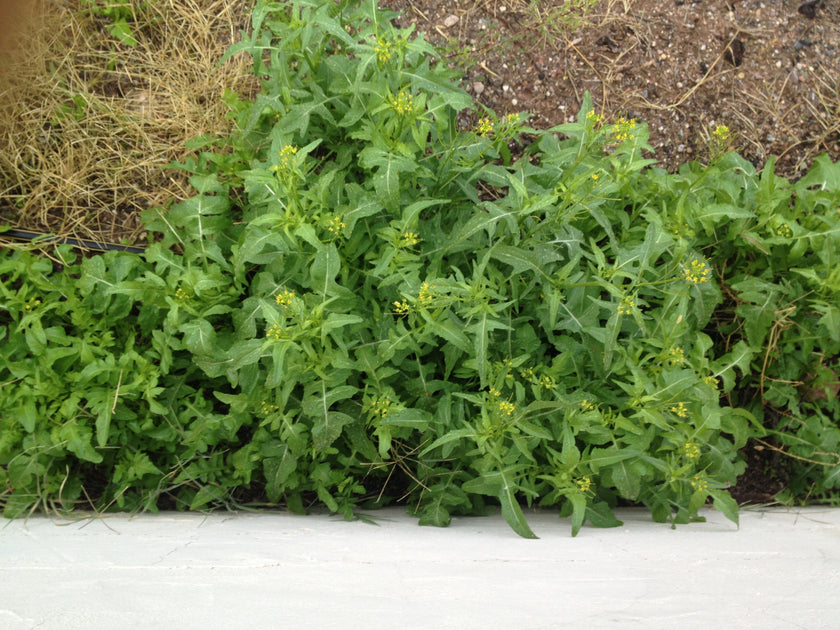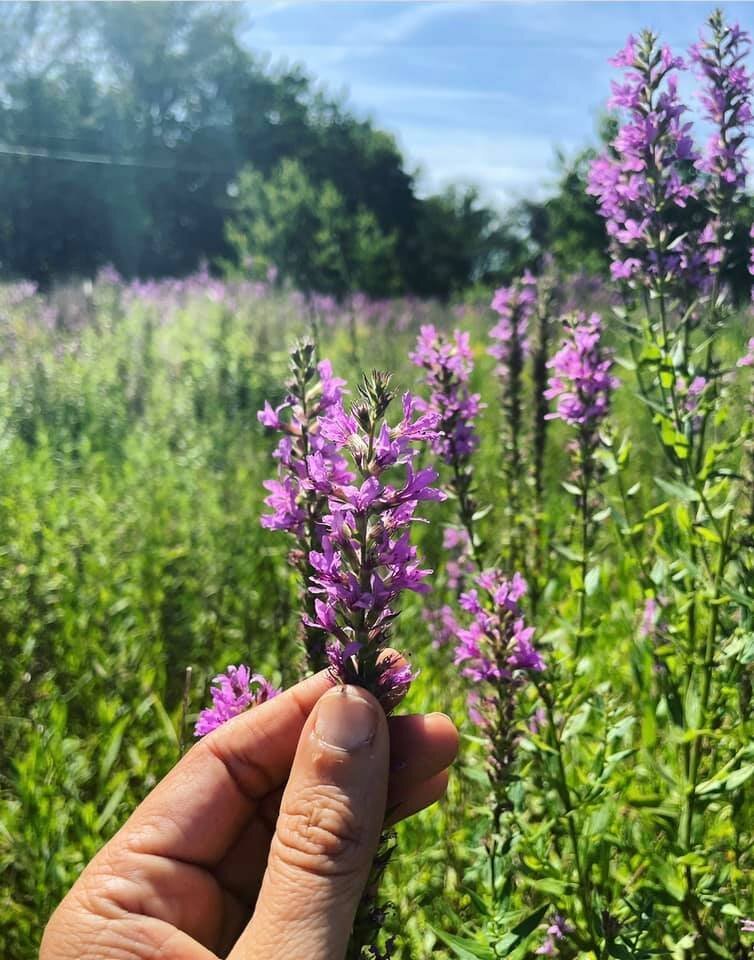London rocket in urban environment
Although the season is slipping by down in the lower desert this green will continue to be available at mid- and high elevations throughout the Southwest through the summer. It has been the premier green of urban areas of the Southwest (Tucson, Phoenix) for many years, and is frequently overlooked. Wherever you know the conditions of the soil (no Roundup being sprayed for instance), where dogs are not likely to soil the plants, or other toxic chemicals have not been deposited in the soil this plant makes an abundant and nutritious foraged green. Read on if you’d like to learn how to use it both medicinally and in the kitchen.
Other Names: tumble mustard, hedge mustard, mostaza, asa, al-shalwa
Origin: Europe, North Africa, Eastern/Central Asia. Introduced throughout the
Mediterranean, and in North America.
Energetics: Herb: Hot & Dry. Pungent, Bitter. Seed: Neutral & Moist. Bitter. Vital Stimulant.
Properties: Counter-irritant, nutritive, moves blood, decongestant, expectorant, febrifuge
Traditional Medicinal Uses: Fevers, cough, chest congestion, painful joints
Edible Parts: Flowers, leaves, seeds
———————————————————————————————-
Join me for my 2024 Intro to Foraging course in the Sonoran Desert!
Beginning March 16
———————————————————————————————-
It’s only Natural
London rocket is considered native to Europe and perhaps into the Middle East. It has since naturalized itself throughout the world (all continents except for Antartica), including all over the Southwest and Northeast US, into the eastern Great Lakes region, and Florida. In the desert Southwest it’s a winter annual. In most other locals in the US it’s a summer annual. We don’t seem to make much note of it here other than it grows in our parking spot, makes more work for landscapers, or an indication that someone’s not keeping up their yard. However, this plant covers great terrain across this globe and some locations still utilize it as food and medicine. In a study in Saudi Arabia our little London rocket was an emblematic species of the following regional habitat – Mediterranean-Saharo-Sindian-Irano-Turanian-Euro-Siberian. That seems like an extensive territory. This little plant is a survivor and an opportunist. Our humble London rocket is still regularly consumed as a wild plant food in Sicily. The people prepare it as a boiled green or added to dishes uncooked.
In the Kitchen
Although there are few accounts of its traditional usage as food, I assure you, this plant is perfectly edible. The simplest place to start is with the leaves. Like several edible members of the Brassicaceae, the raw leaves contain a relative abundance of Vitamin C (68mg/100g). The fresh leaves also contain calcium, potassium, magnesium, iron, and zinc. Simply pick them off of young plants (not yet flowering) and bring into the kitchen. Wash if necessary, then proceed to steam, chop, pureé, boil, fry, or any combination thereof. A little goes a LONG way in a salad, unless you eat chiltepíns like peanuts and don’t taste heat like the rest of us. Like all wild greens I’ve cooked this way, a quick blanche in hot water and then fried in bacon grease is a sure way to acquire new mouths to sample your wild food creations. I have made a “pesto” by grinding the fresh, young leaves with fresh garlic, walnuts, extra virgin olive oil, and sea salt. Combine it all in a food processor and blend until smooth.
London rocket Pesto on pork chop breaded with toasted, ground London rocket seed
London Rocket Pesto
4 handfuls of fresh, young London rocket leaves
3 small garlic cloves
@ 1/4 cup olive oil
@ 2 Tbl walnuts
1/2 tsp sea salt
*You can substitute other vegetable or animal oils to your liking.
Add the fresh flowers as a garnish to this spicy relish and serve it with pork, beef, or chicken – maybe even fish – or a vegetable and rice dish: think mustard. I have enjoyed it as a sandwich spread in place of store-bought mustard.
London rocket seeds
Broadening into the harvest of seeds creates a whole new realm of possibilities. In some ways, the more practical harvest as this annual goes to flower (bolts) quickly rendering the remaining leaves more pungent, and more bitter. The seeds can be harvested from a large group of plants by gently beating the dry tops (seedpods turn purple then beige from immature green) into a bin, onto a towel/sheet, into a skirt, etc. Once harvested, the seeds must be winnowed from the seedpods (if already fully threshed from the harvesting process). This is a nice meditative outdoor task for a slightly breezy day. These seeds can be stored in a jar on the shelf for years if no pests are present. You can also dry toast the seeds in a low heat cast iron pan for a few minutes (they brown quickly). The Brassicaceae are renowned for their oils (canola, for example) and this plant is no exception. The seeds are rich in polyunsaturated oils. Amazingly, the omega 3:omega 6 fatty acid profile is 3.5:1. Most Americans diets are skewed in the opposite direction perhaps 1:5 to 1:50, conversely. I would toast the seeds close to when you plan to use them to limit rancidity. This toasted seed can then be ground in a coffee grinder. The resulting meal possesses a toasty bitter flavor which I have been experimenting with as a breading for baked meats. I’m sure other more ingenious ideas are floating around as yet unmanifested. Despite some ethnobotanical records, the London rocket seeds are not mucilaginous when soaked in water as are other Brassicaceae desert dwellers (e.g., Descurainia spp.). If you’re fortunate enough to find it growing in your environs, get to know it – especially if you like spicy food!
Medicine for the Seasons
Not to be cliché, but food is our medicine. And this pungent little mustard can be used in a variety of ways as medicine. I would consider its basic qualities to be hot & dry. Incidentally, it germinates here in the Sonoran desert upon the arrival of our cold & damp season (relatively speaking). As soon as the winter rains begin to sufficiently soak the ground, London rocket begins to germinate covering the desert floor in a brilliant, emerald green. Not long after, you’ll hear the sniffles, the staccato cough, then the hacking cough, and perhaps fever accompanied by respiratory virus. My first winter season in Tucson I noted how two plants arrived en masse with the cold-wet season: London rocket & malva. Next I noticed how every other person had a chest cold, or sinus congestion, or some derivation thereof. London rocket is a powerful expectorant and respiratory decongestant, and the malva soothes and coats the irritated mucous membranes while gently stimulating the mucous membranes which cover the respiratory passages thereby enhancing localized immunity. How cool was that!?! The humors were being balanced for us if we simply chose to observe our surroundings and respond. Nibble a little London rocket growing in your yard and feel your chest and sinuses expand and clear – no need for Dristan. Throat feeling scratchy and irritated after working out in the cold and rain? Grab a handful of malva from the yard, chop or crush it, soak in water, and sip the tea. Throat is soothed and relieved. The remedy is brought along with the disturbance.
London rocket greens
Traditionally in the Middle East, London rocket is used as a febrifuge, to treat asthma, throat and chest infections, and as a stimulating chest poultice. I have yet to encounter a traditional herbalist from the Southwest who has acknowledged using this plant as medicine. However, there are accounts of various indigenous groups utilizing this plant as food. While staying with a family on the Hopi reservation several years ago I was introduced to their name for this plant, asa. I quickly noted to myself how similar this sounds to the end of the Spanish name for mustard, mostaza. Several native words for introduced plants, animals, tools ring of the intruders, er, introducers’ language.
Warrior Medicine
One particular insight I’ve had into the Nature of this plant is its role in the class of Warrior Medicines. I include various plants in this category (American ginseng, aspen, yarrow, etc.). Often such a plant is either stimulating, invigorating, blood-moving, wound-healing, or a combination thereof. I wouldn’t hesitate to use a fresh plant poultice of London rocket on a wound as first-aid treatment if it was close at hand when needed.
Safety
London rocket is perfectly safe to eat with a very low level of toxicity. I could see it potentially becoming toxic when growing near agricultural effluent where it can accumulate nitrates, but I would avoid all plants growing near conventional, large-scale agriculture. Otherwise, due to its exceptional heating and drying qualities excessive use could lead to imbalance.
More Food for Thought
Unique steroidal saponins have recently been identified in Sisymbrium irio. What this means for the foraging enthusiast is yet unknown. One thing which comes to mind is a tradition of use in women’s reproductive health by the Apache of another Brassicaceae, Western wallflower (Erysimum sp.). Deep down I feel this type of information is largely irrelevant once one has developed a deep connection, through all its seasonal changes, with their local, intact ecosystem. Our bodies become nourished in new ways through a sense of communion with our environment and the details are blurred through a feeling of wholeness.
References
Al-Qudah, Mahmoud A. Zarga, Musa H. Abu. Chemical Composition of essential Oils from
Aerial Parts of Sisymbrium irio from Jordan. January, 2009. University of Jordan.


